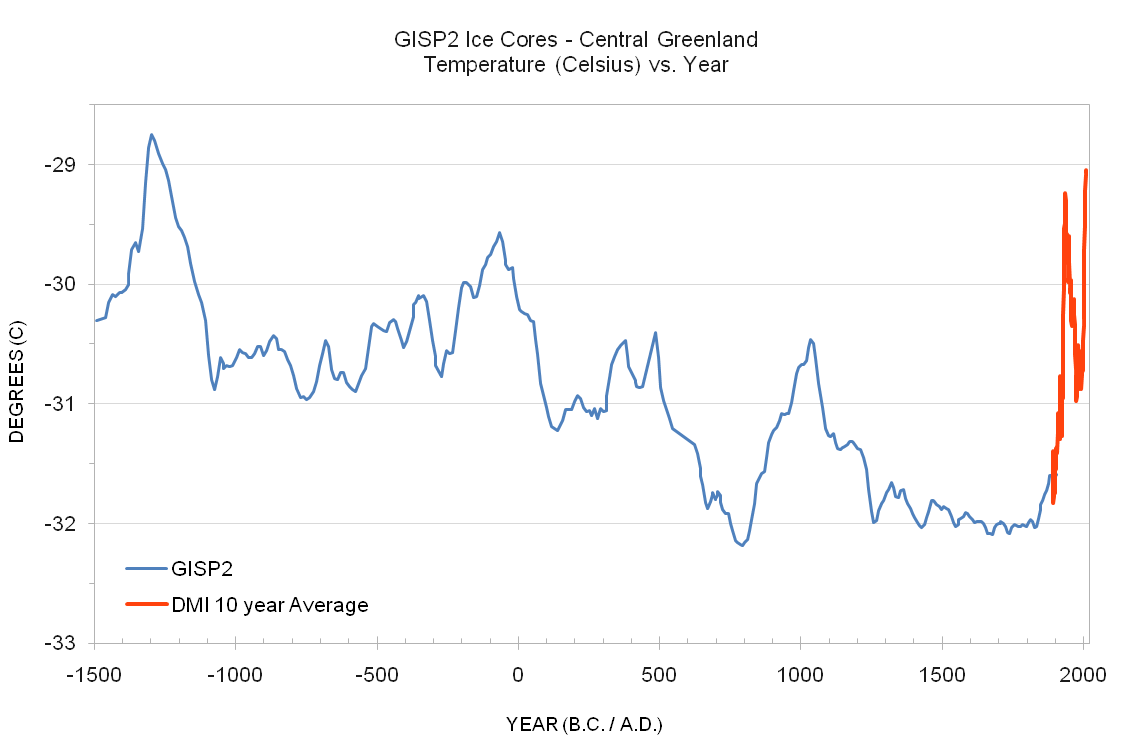Thanks for the links in this ongoing area of interest. I apologize for the long post in advance.
Summary
Mann paper World cool while Norse settlements warm compared to today - interesting, ambitious - note enough data for a definitive conclusion
Young Baffin Bay glacier maxima at time of Norse settlement - different geographical area and contradicted in the settlement area by numerous authors including Mann above - could be right for Baffin Bay but does not apply to Norse settlement areas
Looking at the second article written in 2015 which studies alpine Baffin Island (the island in Canada immediately to the west of Greenland and Western Greenland) both these areas front onto Baffin Bay and from the findings of the paper, it would seem the area was cool at the time of the Viking occupation which was on the southern tip of Greenland.
While it would be easy to pull out ice cores plots like J. Curry's below with the Minoan, Roman and Medieval highs relative to a stab at recent temperatures, this like the Baffin Bay study is limited by being a geographically local source.
Papers dealing with the more wide spread, open ocean conditions of the Norse settlements tell a general temperature story which matches the Norse oral history. I found about 30 applicable papers but I am sure they are more.
The 2013 paper below has the widest scope (bolding is mine)
Regional reconstructions of SSTs off the Norwegian and Icelandic margins are presented, along with a larger-scale reconstruction spanning the NE North Atlantic. The latter indicates that the ‘Medieval Climate Anomaly’ warming was most pronounced before ad 1200, with a long-term cooling trend apparent after ad 1250. This trend persisted until the early 20th century, while in recent decades temperatures have been similar to those inferred for the ‘Medieval Climate Anomaly’. The reconstructions are consistent with other independent records of sea-surface and surface air temperatures from the region, indicating that they are adequately capturing the climate dynamics of the last millennium.
Reconstructions of surface ocean conditions from the northeast Atlantic and Nordic seas during the last millennium The Holocene 1 July 2013: 921-935.
http://hol.sagepub.com/content/23/7/921.abstract
Finally Manns's take on this area from the first paper mjp2 supplied is
"The reconstructed MCA pattern is characterized by warmth over a large part of the North Atlantic, Southern Greenland, the Eurasian Arctic, and parts of North America, which appears to substantially exceed that of the modern late 20th century (1961-1990) baseline and is comparable to or exceeds that of the past one-to-two decades in some regions."
I conclude the weight of evidence suggests the Vikings probably had some cause to call Greenland - green and Vinland (modern Newfoundland) - more agriculturally abundant than today.
As always this is one part of the globe and reinforces the fact that climate did vary in the past and change on the same time scale as recent climate but does not prove or disprove mankind's role in our current variations.
The cause of the colonies demise might have been a change in climate but many authors postulate other reasons (soil erosion, deforestation and even unrecorded European attacks).
https://en.wikipedia.org/wiki/History_of_Greenland
The 2009 Mann paper quoted is more far reaching and ambitious in scope. The study tries to look at the whole globe for the last 1500 years.
The excerpt below shows at the Medieval Climate Anomaly (MCA) some very warm (compared to today) areas notably in the NAtlantic, continental US and and cooler temperatures for the MCA in the southern hemisphere and central Asia. On balance he concludes the world was not warmer in the MCA than now.
I note that Baffin Bay is warm on the MCA map contrary to the paper discussed above.
I also note that the maximum cools on the MCA map do not directly coincide with any data points (except the lightly weighted Tasmanian).
Note in the Little Ice Age (LIA) the world is largely cooler than now as you would expect from numerous studies.
Mann has a valid point that you cannot judge the world from viewpoint of just the North Atlantic. Given the paucity of the data for the MCA (upper right map), More work is needed before the conclusion can be accepted in my opinion.
I would be interested to see any advance in this type of study with all the recent south hemisphere studies or central Asia added. Can anyone point me to some more studies?
- Forums
- Science & Medicine
- Medieval Warming Period not so warm
Medieval Warming Period not so warm, page-4
Featured News
Featured News
The Watchlist
NUZ
NEURIZON THERAPEUTICS LIMITED
Dr Michael Thurn, CEO & MD
Dr Michael Thurn
CEO & MD
SPONSORED BY The Market Online











